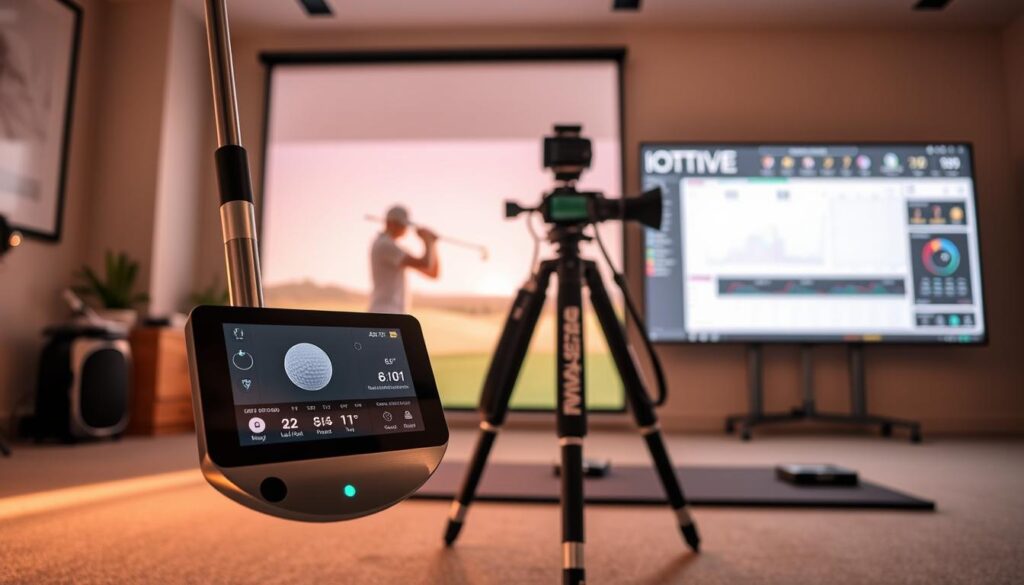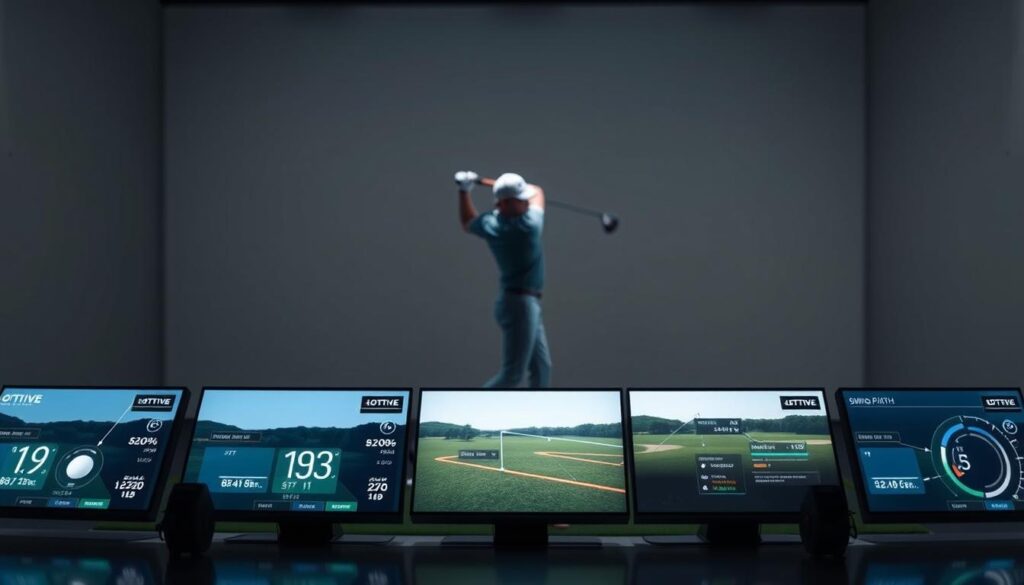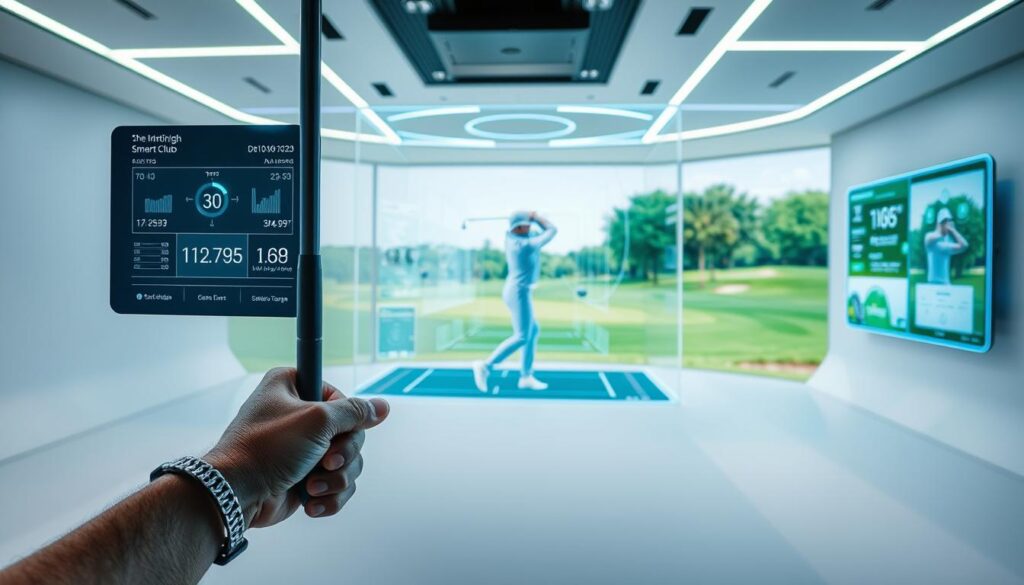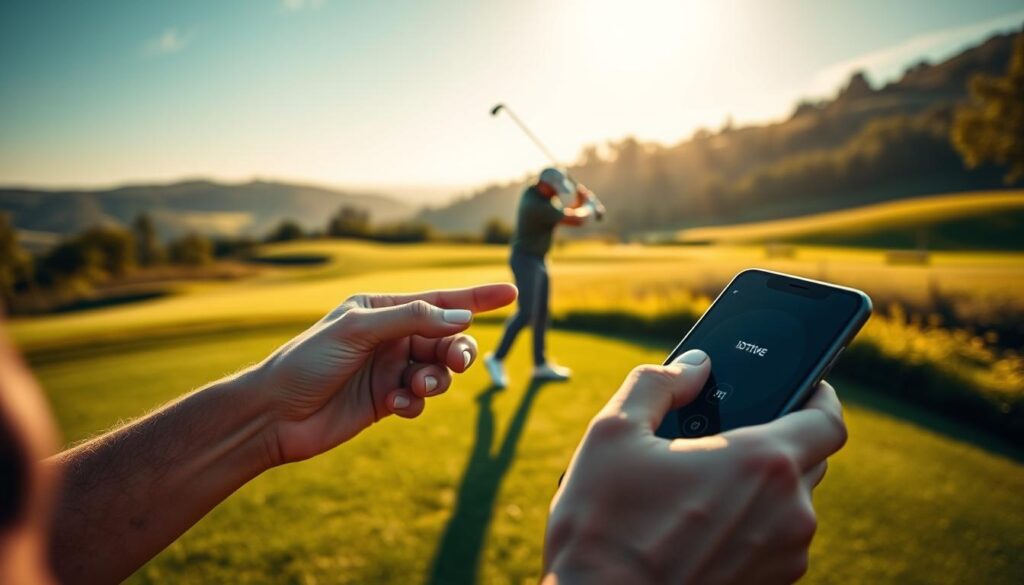Meet Jake, a weekend warrior who spent years battling inconsistency on the course. Despite endless practice, his shots veered left or right without warning. Then came a breakthrough: a palm-sized swing analyzer borrowed from a friend. Within minutes, it revealed his tempo was erratic and his clubface angle inconsistent at impact. Suddenly, years of frustration had clear solutions.

Jake’s story isn’t unique. Players everywhere now access tools once exclusive to touring pros. Sensors and apps break down every detail – from backswing length to ball spin rates. This isn’t magic; it’s measurable science transforming how athletes train.
Today’s gear goes beyond basic stats. Real-time feedback systems highlight flaws invisible to the naked eye. Whether you’re tweaking your stance or refining follow-through, data replaces guesswork. Best part? These innovations fit any budget, helping casual players and serious competitors alike.
Key Takeaways
- Pro-level performance insights now available for all skill levels
- Instant feedback pinpoints exact areas needing improvement
- Combines sensors, apps, and GPS for complete training ecosystems
- Eliminates reliance on subjective “feel” during practice
- Affordable options create personalized improvement plans
The Evolution of Golf Technology
Imagine holding a hickory-shafted club from the 1920s – no grip sensors, no weight sensors, just wood and guesswork. Fast forward to today’s training sessions where players review 3D swing models between shots. This transformation didn’t happen overnight, but it’s redefining how athletes master their craft.
From Traditional Clubs to Smart Equipment
Early equipment focused on durability over precision. Leather grips and wooden heads gave way to carbon-fiber composites and microchips. Now, embedded sensors measure grip pressure and shaft flex during every motion. Coaches once relied on slow-motion video; today’s systems analyze 500 data points per second.
Wireless connectivity turns practice ranges into labs. A single session generates metrics about tempo, rotation, and impact angles. These insights travel instantly to apps, creating personalized drills. No more waiting for weekly lessons to fix persistent errors.
Advancements in Sensor and Feedback Systems
Modern devices use AI to spot patterns humans miss. Tiny accelerometers track wrist movements, while pressure mats map weight shifts. One tour coach notes: “We’ve moved from fixing obvious flaws to optimizing millimeter-level adjustments.”
Real-time audio cues help players correct mid-swing. Vibration alerts signal closed clubfaces, while earbuds whisper tempo reminders. This instant feedback loop turns range time into targeted improvement, not mindless repetition. The pros’ secret? Tech that adapts to their unique biomechanics – now available to everyone.
Deep Dive: Golf – Smart clubs and swing trackers
Picture this: a device smaller than your wallet that deciphers your swing’s hidden flaws. Today’s training aids turn raw motion into actionable insights, helping players fix errors they never knew existed.

Overview of Innovative Products
The HackMotion analyzer redefines wrist mechanics analysis. Strapping onto your lead arm, it tracks 270 degrees of wrist movement during every stroke. Real-time audio cues alert you to excessive flexion – a common culprit behind slices and weak contact.
Blast Golf’s sensor attaches to any grip, transforming standard equipment into smart trainers. It measures critical metrics like backswing length and face rotation timing. At $179.95, this Tour-proven tool offers:
- Instant tempo analysis for full swings and putts
- Stroke-by-stroke comparison against ideal benchmarks
- Personalized drills based on session data
How Technology Transforms Your Stroke
These devices create digital mirrors of your mechanics. The HackMotion system reveals how wrist angles influence clubface alignment at impact. One user reported: “I corrected my hook in two range sessions by monitoring extension patterns.”
Blast’s metrics expose tempo inconsistencies that feel “normal” to players. Its vibration feedback teaches rhythmic transitions between backswing and downswing phases. Result? Cleaner strikes and tighter shot dispersion – without endless video reviews.
Modern analyzers don’t just collect data; they translate physics into improvement. By focusing on measurable changes rather than vague “feel,” players develop repeatable motions that withstand pressure situations. The future of practice lives in your bag – and it speaks your language.
Expert Reviews and Real-World Performance
When top athletes stake their careers on tech, attention follows. Over 200 competitive players now rely on sensor-driven insights to refine their techniques – and their trust speaks volumes.

In-Depth Analysis from Tour Pros
Bryson DeChambeau credits his precision to deWiz’s sequencing analysis: “It transformed how I manage transition timing.” Lydia Ko pairs this system with her coach’s expertise, creating drills that address milliseconds-long inconsistencies.
“The metrics eliminate debates about what happened during a stroke. Instant clarity means faster fixes.”
Comparing Top Models and Their Features
Three devices dominate pro-level training:
| Model | Key Metrics | Price | Best For |
|---|---|---|---|
| deWiz Golf | Tempo, sequencing | $499 | Advanced players |
| Blast Motion | Rotation, impact timing | $179.95 | Mid-handicap improvement |
| Arccos Caddie | Shot tracking, GPS | $199.99 | Course strategy |
Blast’s 8-hour battery outperforms rivals during marathon practice sessions. Meanwhile, deWiz’s haptic feedback helps users feel corrections immediately. Beginners favor Arccos for its GPS-guided course management.
Optimizing Your Golf Swing with Advanced Metrics
What separates a choppy stroke from a buttery-smooth motion? The answer lives in numbers. Modern training tools decode your mechanics with surgical precision, turning raw motion into improvement blueprints.

Measuring Swing Speed and Tempo
Sports Radar’s speed tracker reveals power leaks instantly. One player gained 12 yards off the tee by adjusting his hip rotation timing – data he’d never get from mirror drills. Tempo ratios matter just as much: Tour pros maintain 1.8:1 to 2.2:1 backswing-to-downswing timing in putting strokes.
Blast Golf’s system shows how milliseconds impact consistency. Their sensors measure backstroke duration (0.57-0.63s for elites) and forward stroke speed (0.29-0.31s). Why guess when you can match proven benchmarks?
Improving Short Game and Putting Techniques
Attack angles decide wedge performance. Top players keep theirs between -10° and 0° for crisp contact. Amateurs often swing steeper, losing spin control. Adjusting by 3°-5° can transform bunker escapes and pitch shots.
Putting metrics expose hidden flaws. Face angles beyond ±0.3° at impact cause missed 6-footers. One 18-handicapper fixed his push misses by monitoring real-time face alignment data during practice.
| Skill Level | Tempo Ratio Goal | Attack Angle Target |
|---|---|---|
| Scratch | 1.9:1 | -4° to -2° |
| 10 Handicap | 2.0:1 | -6° to -3° |
| 20 Handicap | 2.1:1 | -8° to -5° |
These aren’t abstract numbers – they’re your roadmap to lower scores. Start measuring, start improving.
Leveraging Mobile Apps for On-the-Go Training
Your smartphone just became your personal swing coach. Modern apps turn backyard drills into studio-quality sessions, offering pro-level insights without bulky equipment.

Real-Time Video Analysis and Data Capture
SportsBox AI revolutionizes practice with instant 3D modeling. Record a standard video, and its AI tracks pelvis sway, shoulder tilt, and spine angles. No markers or sensors needed – just your phone’s camera. One user improved hip rotation by 18% after spotting imbalances in their 3D avatar.
V1 Golf App elevates video review. Its premium version ($9.99/month) lets you draw lines, compare swings side-by-side, and scrub frame-by-frame. Coaches often use it for remote lessons, but self-taught players love its slow-motion analysis tools.
Integrating Smart Feedback for Practice Sessions
Tour Tempo Total Game trains rhythm like a metronome for your stroke. For $25, it teaches tempo ratios proven across 500+ Tour players. Example: Full swings target a 3:1 backswing-to-downswing ratio. Haptic cues in the app help users internalize timing.
These tools create actionable plans from raw data. SportsBox generates drills targeting specific body angles, while V1’s cloud storage tracks progress across months. Instant feedback loops mean adjustments happen mid-session, not days later.
| App | Key Feature | Price | Best Use Case |
|---|---|---|---|
| SportsBox AI | 3D biomechanics tracking | Free trial + subscription | Body mechanics refinement |
| Tour Tempo | Tempo ratio training | $25 one-time | Rhythm improvement |
| V1 Golf | Frame-by-frame analysis | Free/$9.99 monthly | Technical swing adjustments |
Whether you’re analyzing takeaway positions at the range or reviewing putts in your living room, these apps deliver immediate insights. They’re proof that world-class training now fits in your pocket.
Enhancing Course Management and Strategic Play
Course strategy just got a tech-powered makeover. Modern systems turn guesswork into precise calculations, helping players choose smarter targets and avoid trouble spots. Real-time data now guides decisions from tee to green.
Wrist-Worn Course Intelligence
The Shot Scope V5 GPS watch maps 36,000+ layouts worldwide. Know exact yardages to bunkers, water hazards, and green sections before each stroke. Sixteen club tags auto-track every shot, building stats on fairways hit and scoring trends.
Arccos’ AI caddie analyzes millions of shots to suggest optimal clubs. It learns your patterns – like frequent misses left – and adjusts recommendations mid-round. One user cut three strokes by following its layup advice on par fives.
These systems reveal hidden weaknesses through strokes gained analysis. See which parts of your game cost the most shots compared to peers. Instant feedback transforms practice into targeted improvement sessions.
No more scribbling notes or forgetting club distances. Tech handles the tracking while you focus on execution. The result? Confident choices that match your skills and course challenges.
FAQ
How do smart clubs improve my performance?
What metrics should I focus on during training?
Are swing analyzers worth the investment?
Can mobile apps replace in-person coaching?
How does GPS tech help during rounds?
Do these tools work for high handicappers?
How long does it take to see results?
Transform Your IoT Vision Into Reality.
Get free expert insights, architectures & cost breakdowns.
Drop your email to schedule free meeting.